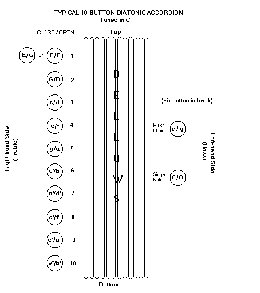Post by Winslow YerxaPost by G***@gmail.comPost by G***@gmail.comI was looking at this layout here, an wondering, why is the first
button written E/G or E/F ?
Cajun accordions are Diatonic, not chromatic. First button is "e" when
bellows going in - "g" when going out.
3rd button is a clue as to what tuning the accordion is. Key of "C" when
bellows pushed IN produces a "C" note - "D" when bellows go out.
"C" is the most common Cajun tuning.
An I was also wondering if the 2 bass
Post by G***@gmail.combuttons are chromatic?
No. One button is the bass note; the other is a chord. On a "C" tuned
accordion, pushing "in" on the bellows produces a "C" bass/chord --- pulling
out on the bellows produces a "G" bass/chord.
----== Posted via Pronews.Com - Unlimited-Unrestricted-Secure Usenet News==----http://www.pronews.comThe#1Newsgroup Service in the World! >100,000 Newsgroups
---= - Total Privacy via Encryption =---
I want to go ahead and buy one, C tunned the Hohner ha114 with the
grill.
One more question, on the tremble when a G chord or A chord needs to
be played, should I just play the single note, or choose a different
chord? Please you opinion is welcomed....
Here's where you run out of good options on a 2-bass instrument like
the HA-114. You only have 2 chords, C and G (on a C instrument). If an
A chord comes up, you have no way to play that chord. Listen closely
to historical players and you can hear them treating the chords like
the home chord (C) and the "other" chord. Trouble is, the "other"
chord (G) is not a good substitute for an F chord, an A minor chord,
and so on. This makes some of that old-style playing sound primitive,
weird, or just plain wrong. Modern diatonic players are more sensitive
to this situation and in some cases just ignore the basses and rely on
accompanying guitar, bass, or keyboards to supply the chordal backing.
Some diatonics have 4, 8, or even 12 bass and chord buttons, but they
tend to be the instruments that have two or three rows of buttons in
the right hand, with each row in a different key, like B/C (used by
Irish players to play in nearly any key), or G-C-F, A-D-G, F-Bb-Eb,
etc (used by Tex-Mex musicians and some French Canadians). What you
often give up on these instruments is register choices. These
instrument already have a large number of reeds to accommodate two or
more keys, and they make up for it by having only two reeds per note -
and you may not be able to switch out the second reed to vary the
sound. By contrast, the HA-114 has four reeds for each note (high, 2
middle, low) and allows you to switch them on and off in any
combination using the knobs on top of the right hand cabinet.- Hide quoted text -
- Show quoted text -
are a few chords in A/G . Thanks again.
